![[Elevation and plan view]](stealth2.gif)
Vehicles
Page Version 1.02
The Deathbird AKA AH 64 Attack Helicopter
Pictures and Data Compiled by Rodney Moorehead
Hughes AH-64
Model 77, AH-64
Origin: Hughes Helicopters, Culver City, USA.
Type: Armed helicopter.
Engines: Two 1,536 shp General Electric T700-700 free-turbine turboshafts.
Dimensions: Diameter of four-blade rotor 48 ft (14.63 m); lenght overall (rotors turning) 57 ft 9 in (17.6 m); length of fuselage 49 ft 5 in (15.06 m); span of wings 16 ft 4 in (4.98 m); height (to top of hub) 12 ft 6.75 in (3.83 m).
Weights: Empty 10,268 lb (4657 kg); maximum loaded 17,650 lb (8006 kg).
Performance: Maximum speed (13,925 lb/6316 kg) 192 mph (309 km/h); maximum cruising speed 182 mph (293 km/h); max vertical climb 2,880 ft (878 m)/ min; max range on internal fuel 380 miles (611 km); ferry range 1,121 miles (1804 km).
Armament: Four wing hardpoints can carry 16 Hellfire missiles or 76 rockets (or a mix of these weapons); turret under fuselage (designed to collapse harmlessly upwards in crash landing) houses 30 mm Chain Gun with 1,200 rounds of varied types of ammunition.
History: First flight (YAH-64) 30 September 1975; entry into service scheduled 1984. (note: actually the first Apache entered service in 1986)
User: USA (Army).
"Hughes is responsible for the rotors and the dynamic components, while Teledyne Ryan produces the bulk of the rest of the airframe (fuselage, wings, engine nacelles, avionic bays, canopy and tail unit). The entire structure is designed to withstand hits with any type of ammunition up to 23 mm calibre. The main blades, for example, each have five stainless-steel spars, with structural glassfibre tube linings, a laminated stainless-steel skin and composite rear section, all bonded together." (however, on the next page the text says: "The entire aircraft is designed to withstand hits from 12.7 mm (0.5 in) projectiles, and most crucial parts are designed to withstand 23 mm (0.9 in).")
AH-64 Apache's 30 mm chaingun can kill a tank from 1.5 km and the Hellfire-missiles have a range of 6 km. Apache's newer version, AH-64D Longbow Apache can use radar-guided Hellfires, which can be fired in "fire and forget"-fashion. As far as I know, the main differences between AH-64 and AH-64D are the millimeter-wave radar system and related subsystems and engines. AH-64 Apache appears in many computer simulations: AH-64D Longbow and (the good old) LHX Attack Chopper by Electronic Arts, Apache Longbow and Longbow 2 by Digital Integration, Gunship and Gunship 2000 by MicroProse, etc. It has also appeared in many movies.
The Cromwell
A corvette class warship, it displaced 114 tons and had a top speed of over fifty knots on smooth seas. It was a sleek, sharp prowed vessel, painted a flat, sinister black. Its streamlined, oddly faceted contours gave it the appearance of a gigantic knife blade.
Weaponry consisted of 3, 40mm cannons placed amidships, the barrels jutting out from behind metal shielding. Also present was an Exocet anti ship missile system and a BOFORS deck cannon, a pair of tripod mounted L7-A1 Heavy Caliber machine guns, and even a Limbo anti submarine depth charge launcher.
Power came from a regenerative gas turbine engine with back up diesel engines.
The ship was one of the first to ever use the ocean stealth technology, and the UK only produced a handful of them before the Skydark. The were used during the Falkland war.
Mention in Savage Sun and Hell Rising.
A real life Stealth Ship below: As usual, all links and information kept strictly as is, in the chance that the page might eventually be removed from the net.
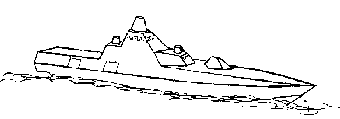
In 1988 the Swedish Navy started planning for the acquisition of two new ship classes, corvettes of types YSM (Ytstridsfartyg Mindre = Surface Combatant Small) and YSS (Ytstridsfartyg Större = Surface Combatant Large).
The very successful trials with the test stealth ship Smyge gave a lot of knowledge that was applied to the YSM project.
Due to economic considerations, YSM and YSS became a single ship, YS2000 (Surface Combatant 2000), in 1993. The original plan called for two versions of YS2000, series 1 primarily an ASW platform and series 2 slightly longer with SSM and SAM as well as a helicopter hangar allowing a helicopter to be permanently stationed aboard.
After nine years of development work, the Swedish government in 1995 ordered two ships from Karlskronavarvet AB, to be delivered in 1999 and 2000, from series 1, with an option on two more.
Construction started during autumn 1996.
In Aug 1999, a further two were ordered, bringing the total to six.
The lead ship, Visby, was launched on June 8:th 2000. After trials it will enter full operational service in 2004 with Andra ytstridsflottiljen (2. surface attack) based outside Stockholm. The remaining five ships will be delivered with one year intervals.
K 31 HMS Visby K 32 HMS Helsingborg K 33 HMS Härnösand K 34 HMS Nyköping K 35 HMS Karlstad K 36 HMS Uddevalla
Missions for both the military and civilian arm of the Swedish defense forces include command, surveillance, anti submarine warfare, mine hunting and international missions.
YS2000 is a fully stealthed design with weapons and workspaces behind hatches, low concealed exhaust pipes to minimize IR signature and a completely unmagnetic hull similar to the Landsort class minesweeper. All work with weapons and mines is conducted inside the ship and it is impossible to see which weapons are carried from the outside.
The hull is designed especially for waterjet propulsion and is built and designed in three sections. The carbon fiber reinforced plastic hull is very light and unmagnetic.
There are no known foreign counterparts to YS2000.
Speeds: 18 knot cruise, 35+ knot maximum
Length: 72.8 m
Width: 10.4 m
Depth: 2.40 m
Deplaces: 600 tons
Engines: Diesel and gasturbine designed to minimize
noise.
Low speed, 0 - 14 knot, two diesels, 2.6 MW together
High speed, 0 - 35-40 knot, four gas turbines, 16 MW
Propulsion: Waterjet. Swedish KaMeWa is world leading
in waterjet propulsion and seem a likely
candidate to supply the propulsion systems.
Sensors: Passive TAS (Towed Array Sonar), active VDS
(Variable Depth Sonar), active hullsonar,
sonar and camera equipped ROVs.
Surveillance and navigation radar and ESM.
Weapons: 40 cm ASW torpedos, ASW grenades,
57 mm AA automatic cannon,
mines and RBS 15 anti ship missile.
Information from Marinnytt nr 2 1995, Ny Teknik
1995:42 and courtesy Karlskronavarvet AB.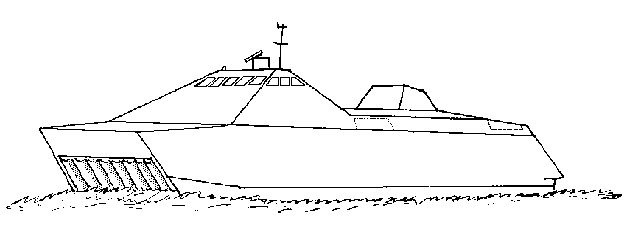 The Swedish stealth ship HMS Smyge is a purpose built test platform for
developing stealth technology, test new weapon systems, sensors, communications
systems and navigatin equipment as well as gaining experience with surface
effect ships (SES).
The Swedish stealth ship HMS Smyge is a purpose built test platform for
developing stealth technology, test new weapon systems, sensors, communications
systems and navigatin equipment as well as gaining experience with surface
effect ships (SES).
It was first shown publicly in 1991. During the following years it was trialled in many regards (for example there is no deck to stand on).
It is not a prototype for our next generation combat vessels, also beeing built by Karlskronavarvet AB, for one thing it is too small, and the weapons fit is not representative for a ship this size, but it has a little of everything for evaluation purposes.
Configuration is a side-keel hovercraft, or SES - surface effect ship, mostly manufactured of kevlar and glassfibre.
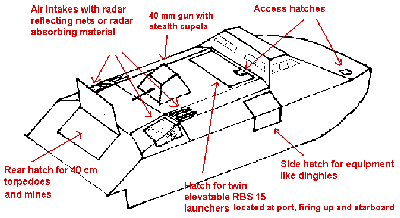
It is designed to reduce radar, IR and noise signatures. All structures consist
of angled flat surfaces and all in- and outlets are screened or fitted with
radar absorbent material, the engines' exhausts are cooled, using three
different methods to evaluate them, and the use of water jets makes for a small
noise signature.
As only very little of the hull projects into the water (more than 80% of the ship is supported by the air cushion), it makes for a small pressure signature (there are Norwegian mine hunters with the same configuration). This also makes it relatively insensitive to underwater explosions.
It has conformal and retractible antennas,
including the elevating radar mast.
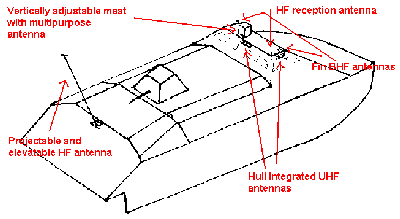
Displacement: 140 tonnes
Length: 30.4 m (27 m waterline)
Beam: 11.4m
Draft 1.9 m at rest; 0.7 on the air cushion.
Speed: More than 40 kt in calm weather
Crew: 14 (6 officers and 8 conscripts)
Propulsion: Two 2040 kW MCR diesels powering
KaMeWa Waterjet "63" water jets
Lift: Two 460 kW Scania DSI 14 diesels powering
the lift fans
Armament: 40 mm gun type TRINITY
The barrel can be depressed into the hull
and covered by a hatch.
Two RBS 15 anti-ship missiles
Torpedoes
Mines
Anti-submarine warfare equipment
Mine counter measures equipment
The mast is there to comply with civilian regulations regarding lights etc. It also camouflages the stealthyness so that all other trials can be performed in view of the public. It is easily removed for stealth trials.
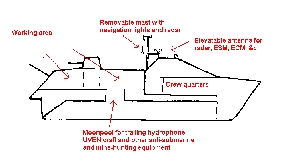
There is an open shaft located at the ship's centre of gravity from the hold
down to the water, a "moonpool". This reduces forces on equipment
deployed, for example hydrophones, UVEN craft and various anti submarine and
mine hunting equipment.
The Smyge text written before 1994, last modified 1996 May 03, The Visby text written 1995, updated 1996 May 03, 2000 July 07, images created in 1995 and 1996. Document last modified 2000 July 07 by Urban Fredriksson
The Sandcat
Mark Ellis based this vehicle on the one shown below. Data taken from the following page: http://www.marcav.ctc.com/projects/m113/index.htm All links retained.

The goal of this project is to upgrade the existing electric drive M113 personnel carrier to improve performance and space efficiency. Activities include: design and fabrication of an advanced lead acid battery-based energy storage system, a 55 kW Auxiliary Power Unit (APU), a distributed network-based vehicle power management system, installation of these components and a low noise band track into the existing electric drive M113, and support to subsequent testing and vehicle demonstrations.
Aurora
1990 GROOM LAKE, NEVADA, USA In the early hours of the morning on January 30, 1992, people all over Southern California were awakened by a loud boom. It was not the first to rattle window panes in Los Angeles, nor has it been the last. US Geological Survey specialists looked at their seismographs, which registered the event as if it had been another earth tremor. A few hours later, they decided the disturbance had been caused by an unidentified flying object traveling at Mach 3.1. They even figured out where it was heading - straight for the US Air Force's top secret Groom Lake base in Nevada.
In spite of official denials, the evidence indicates that the United States is operating a very fast, very secret spy plane. Most people call it Aurora, after an item listed by mistake in a 1985 Pentagon budget document, though it most probably has another code name. The strongest evidence for the existence of Aurora is that the US Air Force retired its Lockheed SR-71 Blackbirds in 1990 without replacing them. The Air Force says its spying can be done by U-2s and satellites, but neither are as responsive as a supersonic highflying craft such as the SR-71.
Eye witnesses have seen unusual triangle-shaped aircraft in flight over the United States and the United Kingdom's North Sea. Several have heard a distinctive low frequency rumble followed by a very loud roar, which could be the exotic engine used by a Mach 6 (4,400 miles per hour) aircraft. Experts say a methane-burning combined cycle ramjet engine (uniting rocket and ramjet designs) could have been developed to power Aurora.
Observers in California have also reported seeing a large aircraft with a delta-wing shape and foreplanes. Some think this could be an airborne launch platform for satellite-delivery rockets or even the Aurora, before its more advanced engines were developed. No matter what speculation takes place, it seems the secrets that lie beyond the mountains of the Nevada desert will remain until the US military decides otherwise.
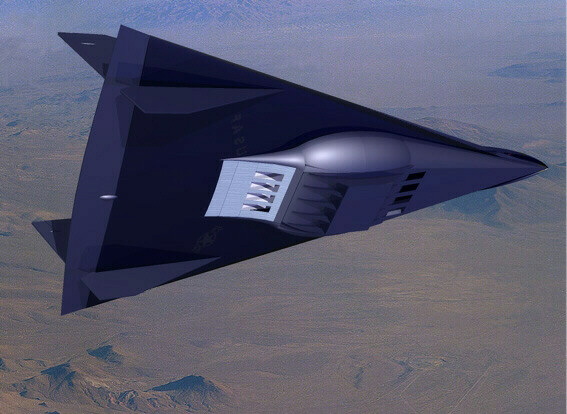
Hover-Tanks
Introduced in Armageddon Axis, these experimental tanks were to have been deployed as part of the super infantry program. Only a handful of these vehicles were ever created and at least one had been deployed at the Dulce Facility to use in its defense.
The tank appears to be a slightly flattened box. A pair of MG 73 swivel mounted machine guns sprouted from the open deck. From a shielded assembly protruded a ten foot 75mm cannon. Skirts of alloy reached almost to the ground. They rose and fell as the vehicle moved on a powerful cushion of air.
The pilot was located below the main deck, and this is also where the gunner for the 75mm cannon was located. Along with ammunition, the engine and so forth.
The armor is similar to the steel ceramic bond that was used on the Sandcats (see above), making it impervious to most small arms fire but it can be disabled or destroyed by anti tank weapons.
A special thanks to Michael Chestnutt for providing the images of a SK-5, a prototype hovercraft. It will give you a good idea what the Hover Tank would look like.
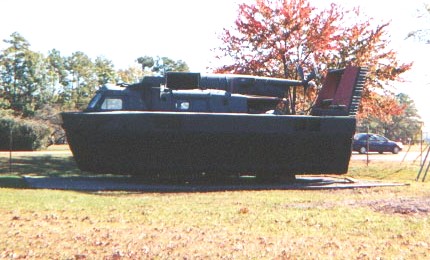
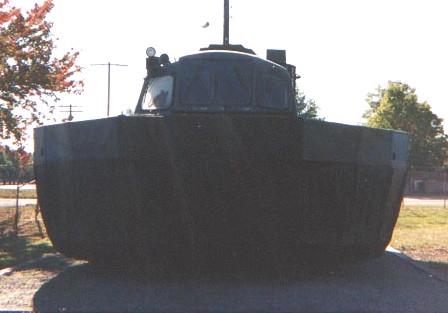
Burrower
The vehicle was about fifteen feet long and approximately a yard in diameter. The tip was a dully gleaming armature. It was made of segmented metal joints hinged in several places, coated in rivets. The armature was three spinning blades that were used for tunneling. The vehicle was armored with Tungsten steel and Vanadium alloy. The body was supported by scoop like treads and it was as long as a land rover. It was originally created as an excavation machine, but was converted to defense role at Dulce, New Mexico. Introduced in Armageddon Axis.
Created on 02/18/01
Updated on 04/1001